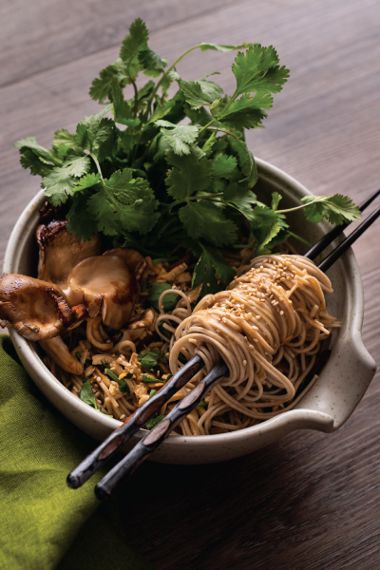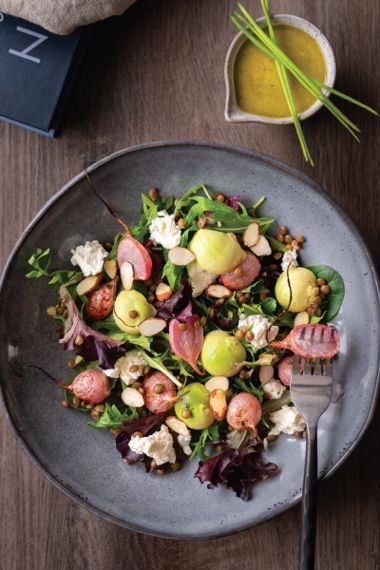The 6 Best Green Recipes to Spring Clean Your Diet
Snow turns to mud. Mud turns to bright shades of green bursting forth. Catching a glimpse of the first greens of the season poking up through the ground is certainly energizing, a harbinger of gloriously warmer days ahead. And it’s a promise of fresher tasting meals to come after a cold, dark winter featuring a steady rotation of heavier fare. You could be forgiven for not wanting to see another root vegetable.
There are so many greens, cultivated and wild, to add into your culinary repertoire for vibrant flavour nuances and plenty of nutrition. These days, there’s a cacophony of advice about what constitutes a healthy way to eat, but there’s one thing that virtually every diet agrees on: you should eat more greens. For very few calories, you get a payload of body-benefitting antioxidants and micronutrients from spinach, asparagus, and their ilk.
Get into the spirit of the season with these green-themed recipes that focus on what’s fresh and exciting. Consider them a springboard into refreshing flavours that will have you working everything from sprightly asparagus to peppery arugula into your diet every which way. It’s time to awaken your taste buds from hibernation.

A spread of vibrant pea hummus adds an extra layer of nuance to these lunch wraps—a great way to breathe new life into your sandwich routine. If desired, sorrel or basil can replace the mint in the hummus. And if you want to go plant only, slices of smoked/baked tofu are a good stand-in for chicken. Go ahead and use leftovers of the hummus as a dip or a spread for other sandwiches.

These saucy noodles will bring a fiery kick to your spring menu and show that delicious plant-based eating can spill over into different cuisines of the world. Dandelion greens or tender spring spinach are good stand-ins for watercress. Place the bottle of chili sauce on the table for anyone who wants to really bring the heat.

This frittata seems complex, yet it has a decided simplicity that makes for an exciting meal even on a busy weeknight. Whether store-bought or foraged from your lawn or local park, dandelion greens lend pesto a pleasant earthy bitterness. Spring arugula would serve well as a green substitution. Smoked salmon is a good stand-in for trout, or you can use previously cooked fresh trout or salmon.
Taste the season
These days, you can get asparagus, arugula, and green peas year round. But the local growing season for these items is fleeting, so when they’re available be sure to catch them while you can to add hyper-seasonal flair to your diet.
| Green | Tasting notes | Culinary uses |
| dandelion greens | One person’s weed-filled lawn might be another person’s salad bar. Recognizable by their jagged-edged leaves, dandelion greens are bitter tasting when raw, but less so when cooked. | Serve atop burgers or grilled cheese, toss with other salad greens, sauté and toss with scrambled eggs, add to pasta dishes, or purée in soups and sauces. |
| fiddleheads | The tightly coiled fronds of the ostrich fern have a crisp texture and a flavour that wanders somewhere between asparagus and broccoli. | From stir-fries to frittatas and pizza, you can use fiddleheads in almost any recipe calling for cooked asparagus. They’re also great when simply sautéed and seasoned with salt and olive oil. |
| garlic scapes | The curly shoots from the garlic plant have a less pungent punch and fresher vegetal flavour than formed garlic bulbs. | In any recipe that calls for garlic—sautés, sauces, pestos, stir-fries, and more—you can substitute garlic scapes. Since they’re milder, you may want to use more to get a stronger flavour. That also means you can use them raw, like you would green onions, without their flavour overpowering a dish. |
| garlic mustard | This wild edible has earned the title of being invasive in many geographical areas. The scallop-edged leaves have a taste that is, you guessed it, a cross between mustard greens and garlic. As temperatures warm, the flavour becomes more bitter. | Toss into mashed potato, stir into a pot of cooked grains, add straight-up into salads, or fold into minestrone and other chunky soups. It’s also another candidate for a pesto green. |
| ramps | Also known as wild leeks, ramps are a wild onion native to North America with a lively garlicky flavour. Both the small white bulbs and broad green leaves are edible. | Blend all parts of ramps into pestos or use in recipes like you would garlic. They’re also great when pickled to extend their season. Or toss a bunch of whole ramps on the grill to pick up a bit of smoky char and then serve with squirts of lemon juice. |
| sorrel | The perennial herb that is related to rhubarb has a noticeable tang, which is why it’s been called “lemonade in a leaf.” Its lip-puckering flavour, however, wanes with cooking. | Treat it like you would other delicate greens or herbs and add to salads, sandwiches, lentil stews, pesto, soups, and even smoothies. |
Herbalicious
When it comes to greens, herbs prove that amazing things can come in small packages. Concentrated in flavour compounds, they’re the rock stars of healthy eating by exciting and rousing the taste buds.
Nearly every spring-minded dish imaginable, from soups to salads and frittatas, can benefit from fresh tastes of thyme, basil, mint, and other herbs. Not to be overlooked, the range of herbs will imbue dishes with extra nutritional potency as they contain an arsenal of important micronutrients and antioxidants.
In fact, the liberal use of herbs such as parsley and oregano are thought to be one reason why the famed Mediterranean diet is so darn healthy. This is all to say that whatever you’re cooking, be sure to keep a bunch of green herbs nearby to ramp up the flavour and nutrition with very little effort.
Queen green
If you struggle to eat enough green vegetables, or simply want to top up the nutrition you’re already getting from your daily salads, adding a scoop of greens powders into your daily routine can be a wise move.
Made by dehydrating various vegetables, fruits, and other compounds and then crushing them into a fine powder, greens powders are typically a nutrient-dense, antioxidant-rich product. They’re definitely an insurance policy worth taking out.
Flavours and dissolvability have improved, making it easy to add them to water, smoothies, and a bowl of yogurt. But what these powders are not is a direct substitute for vegetables and fruits.








